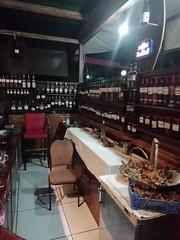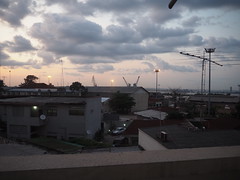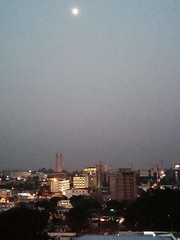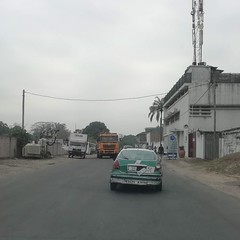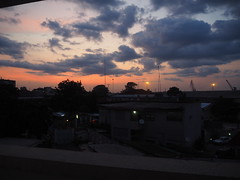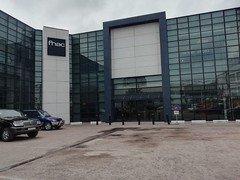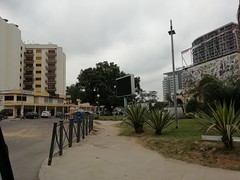Brazzaville
Brazzaville (French: [bʁazavil], Kongo: Kintamo, Nkuna, Kintambo, Ntamo, Mavula, Tandala, Mfwa, Mfua; Teke: M'fa, Mfaa, Mfa, Mfoa) is the capital and largest city of the Republic of the Congo (Congo Republic). Constituting the financial and administrative centre of the country, it is located on the north side of the Congo River, opposite Kinshasa, the capital city of the Democratic Republic of the Congo (DR Congo).
The population of the capital is estimated to exceed 1.8 million residents, comprising more than a third of the national populace. Some 40% are employed in non-agricultural professions. During World War II, Brazzaville was also the capital of Free France between 1940 and 1942.
In 2013, Brazzaville was designated a City of Music by UNESCO; since then it has also been a member of the Creative Cities Network.
Geography
Brazzaville covers a large area to the north of the Congo River, just below the Pool Malebo. Mbamu, a large island within the Pool, is part of the Republic of Congo's territory.
Brazzaville is inland from the Atlantic Ocean and approximately south of the equator. The city is a commune that is separated from the other regions of the republic; it is surrounded by the Pool Department. Around the city are large plains. The town is relatively flat, and situated at an altitude of . Downriver the Congo has numerous rapids, known as Livingston Falls, preventing navigation upriver to this point from its mouth at the Atlantic.
Kinshasa, the capital of the Democratic Republic of the Congo, is located on the southern bank of the Congo, directly across from Brazzaville. To distinguish between the two African countries that have "Congo" in their names, the Republic of the Congo is sometimes called Congo-Brazzaville, as opposed to Congo-Kinshasa. Kinshasa is more than five times larger than Brazzaville in population. This is the only place in the world where two national capital cities developed on opposite banks of a river, within sight of each other.
In March 2018, the "Brazzaville Declaration" was signed to promote better management and conservation of the Cuvette Centrale, a region in Congo Basin and primarily in DRC. It is the world's largest tropical peatland, made up of swamp forests. Conservation of this area is important for the survival of megafauna, and also critical to the world's climate. Burning the peat would release too much carbon and raise the earth's temperature. The declaration to save peatlands as the world's largest terrestrial organic carbon stock was signed by Democratic Republic of the Congo, the Republic of the Congo, and Indonesia, which also has peatlands.
History
Brazzaville was founded by the French colonial empire upon an existing indigenous Bateke settlement called Ncuna, during the Scramble for Africa when European nations established spheres of influence on the continent. The Italian-born explorer Pierre Savorgnan de Brazza, who was granted French citizenship in 1874, officially founded the settlement on 10 September 1880; it commemorates his name.
The local King, Makoko of the Téké, signed a treaty of protection with de Brazza, which subjugated his lands to the French Empire. From October 1880 until May 1882, a small squad of troops led by Senegalese Sergeant Malamine Camara occupied the site, in order to prevent the land from falling into Belgian hands. Their forces were active on the south side of the river, where King Leopold II ruled the Belgian Congo for a period as a private holding. The first large-scale building work of the city began four years later, as the French competed with Léopoldville (now Kinshasa) which Belgian colonists were developing on the south side of the river.
The Berlin Conference of 1884 placed French control over this area on an official footing. The city became the capital of the French Congo in 1904. It continued as capital when French Equatorial Africa was founded in 1910, as a federation of French colonial states: it included Gabon, the Central African Republic, and Chad until 1960. From 1910 to 1915 the major municipal buildings were constructed, including a courthouse and headquarters for the Banque de l'AEF and Institut Pasteur.
In 1934, the Congo–Ocean Railway opened, linking Brazzaville with the Atlantic port of Pointe-Noire and bypassing the rapids on the Congo River. Construction of the railway resulted in the deaths of more than 17,000 Africans, and the people revolted against the French in 1928.
During World War II, Brazzaville and the rest of French Equatorial Africa remained beyond the control of Vichy France, which served the Nazi occupation. The city served as the capital of France Libre from 1940 to 1943. In 1944, Brazzaville hosted a meeting of the French resistance forces and representatives of France's African colonies. The resulting Brazzaville Declaration represented an attempt to redefine the relationship between France and its African colonies.
Until the 1960s, the city was divided into European (the centre of the city) and African sections (Poto-Poto, Bacongo, and Makélékélé). In 1980, it became a "commune," separated from the surrounding Pool Department and divided into nine "arrondissements" (boroughs) along the French model of administration.
Since the late 20th century, the city has frequently been a staging ground for wars, including internal conflicts between rebel and government forces. It has been a base of conflicts between forces of the Republic of the Congo, the Democratic Republic of the Congo (DRC), and Angola. During the 1990s, civil wars resulted in thousands of civilian deaths here and forced hundreds of thousands of refugees to flee the city.
More recently thousands of people leaving the DRC have made their way to Brazzaville; the local United Nations force and the DRC government have accused the city of deporting thousands of these refugees.
In April 2016 fighting occurred between police and local militia units, with at least 18 people killed.
Demographics
As of the 2007 census, the city had a population of 1.37 million. The projection of the CNSEE (national statistics centre) estimated an increase to 1.7 million by 2015, but the projection was made before 2007 and was based on a lower estimate of the population (1.26 million) than that recorded in the census.
The United Nations Population Division estimate for 2014 is 1.83 million. Kinshasa, DRC, had more than 10 million inhabitants in 2014.
Together with Kinshasa, the combined conurbation of Kinshasa-Brazzaville has about 12 million inhabitants. Significant political and infrastructure challenges prevent the two cities from functioning with any meaningful connection.
Since the mid-19th century, the two cities have been rivals in trade, sports and power. There have been proposals to connect the two capitals by a Brazzaville–Kinshasa Bridge. In 2018, with relative peace re-established in the region, the African Development Bank and Africa50 signed a deal with both governments to develop the project.
Culture
Roger Erell, a highly regarded architect, also designed a house in the city for Charles de Gaulle when he was the leader of Free France here. Other buildings include the Pierre Savorgnan de Brazza Mausoleum, the Nabemba Tower, and the Congressional Palace (Brazzaville).
The Marien Ngouabi Mausoleum, Brazzaville Zoo, and the Poto-Poto School of Painting are also destinations for visitors and city residents.
Places of worship
Many Congolese converted to Catholicism during the French colonial period. Christian churches are most prevalent in the city, where the Roman Catholic Church has an archdiocese. Since then, churches have been established by new immigrants and by local adoption of evangelical Protestantism. Examples include the Basilica of Sainte-Anne-du-Congo in Brazzaville, Greek Orthodox Archdiocese of Brazzaville and Gabon (Patriarchate of Alexandria and All Africa), Evangelical Church of Congo (World Communion of Reformed Churches), and Assemblies of God.
Notable people
- Pierre Savorgnan de Brazza (1852–1905), eponymous founder.
- Prosper Philippe Augouard, (1852–1921) French Catholic priest, missionary and explorer, settled Brazzaville in 1887.
- Ambroise Noumazalaye (1933–2007) Prime Minister of Congo-Brazzaville, 1966 to 1968
- Jean Serge Essous (1935-2009) a Congolese saxophonist & clarinetist
- Emmanuel Dongala (born 1941) a Congolese chemist and novelist.
- Patience Dabany (born 1941) singer, musician and First Lady of Gabon, 1967 to 1987.
- Antoinette Sassou Nguesso (born 1945) First Lady of the Republic of the Congo since 1997
- Aurlus Mabélé (1953–2020) a Congolese singer and composer.
- Charles Richard Mondjo (born 1954) Chief of Staff of the Congo Armed Forces, 2002 to 2012.
- Dominique Ntsiété (1940-2012), senator
- Ali Bongo Ondimba (born 1959), Gabonese politician, 3rd President of Gabon since 2009.
- Alain Akouala Atipault (born 1959) politician and government Minister.
- Frédéric Bintsamou (born 1964) a Protestant clergyman and leader of the "semi-religious" rebel group The Ninjas
- Bill Kouélany (born 1965) a Congolese artist, writer and set designer.
- Alain Mabanckou (born 1966) novelist, journalist, poet and academic
- Cyril Kongo (born 1969), a French painter and graffiti artist, lived in Brazzaville in the 80s.
- Dominique Tchimbakala (born 1977) journalist and TV presenter, news anchor for TV5Monde.
- Gaitana (born 1979), Ukrainian singer who lived in Brazzaville for five years.
Twin towns and sister cities
- Dresden, Germany
- Weihai, China
- Kinshasa, Democratic Republic of the Congo
External links
- FUSION CITIES, consolidation of movement, urban analysis seminar with vectorised maps of the agglomeration by TU Darmstadt, 2009
- Maria Petringa's 1997 biographical article on Savorgnan de Brazza, describing events leading to the founding of Brazzaville
Looking for places related to Brazzaville?
Those are other destinations to find places related to Brazzaville:


